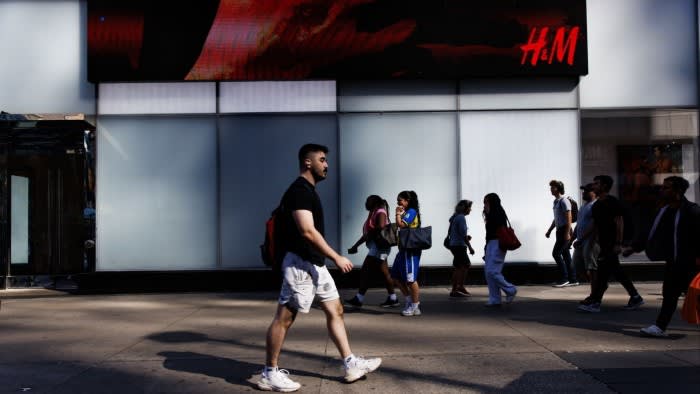Unlock the Editor’s Digest for free
Roula Khalaf, Editor of the FT, selects her favourite stories in this weekly newsletter.
H&M has all but abandoned its profit target for the year as the Swedish fast-fashion chain struggles to boost margins amid higher material and marketing costs and intense competition from rivals such as Shein and Zara.
Daniel Ervér, H&M’s chief executive since January, said “at present we estimate that this year’s operating margin will be lower” than the 10 per cent forecast.
Operating profit in the third quarter dropped 26 per cent from a year earlier to SKr3.5bn ($350mn), well below the average analysts’ expectations of SKr4.9bn. The operating margin for the first nine months was 7.4 per cent.
H&M has struggled for more than a decade with weak profitability after being outpaced by Spain’s Inditex, the world’s largest fashion retailer and owner of the Zara brand. In recent years the Swedish company has come under intense pressure from lower-cost rivals such as Shein and Temu.
The expected miss on its much-touted profitability target is a blow for Ervér, who took over after the sudden resignation of previous boss Helena Helmersson.
Ervér had in recent months said that H&M needed to boost sales again while reaching its profitability target.
The company’s shares fell 8 per cent in early trading in Stockholm on Thursday. They are down about 5 per cent since the start of the year, while Inditex’s have risen roughly 35 per cent.
H&M’s operating profit margin fell from more than 20 per cent in 2010 to just 3.2 per cent in 2022, before rebounding to 6.2 per cent. Investors accused it of relying on opening new stores to increase sales before the pandemic while largely ignoring the drop in profitability.
In recent years H&M has closed a significant number of stores, while it announced last month that it would shut digital fashion outlet Afound, one of its numerous smaller brands.
Its sales in the third quarter declined by 3 per cent to SKr59bn after a bad start due to cold weather in June, and were flat in local currency terms.
H&M added on Thursday that its autumn collection had been “very well received” after a large marketing campaign featuring singer Charli XCX and that sales in September — in its fourth quarter — were expected to increase by 11 per cent in local currencies.
“2024 is a year in which we’re laying the foundation for future growth. We’re increasing the pace of improvements in our customer offering and deprioritising things that don’t strengthen our brands or contribute to our sales and profitability . . . External factors have impacted our sales revenue and purchasing costs more than we expected,” said Ervér, who added that he expected sales and margins to increase.


